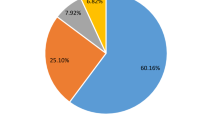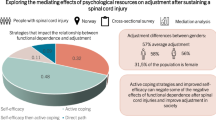Abstract
Study design:
Retrospective, 1 year case series.
Objectives:
To analyze the relationship between gender, age, injury-related variables and rehabilitation outcomes in patients with spinal cord injury (SCI).
Setting:
Tertiary Rehabilitation Center, Inpatient rehabilitation unit, India.
Methods:
The data from a series of SCI cases were analyzed. Each case was followed from admission into the hospital until their discharge. Patients were described according to age, gender, etiology of SCI, neurological classification, medical complications, American spinal injury association (ASIA) classification, length of rehabilitation stay and spinal cord independence measure (SCIM).
Results:
Forty-seven new SCI cases, 37 (78.7%) male and 10 (21.3%) female patients, were reported over a 1-year period during 2009–2010. Male patients were younger than the female ones, but the difference was not statistically significant. There was no statistically significant relationship between age or gender, and the following SCI variables: ASIA classification, neurological classification, SCI complications and length of stay (P>0.05). Traumatic etiology and Pott’s disease was found be related with gender (P<0.05). There was no statistically significant relationship between age or gender and SCIM score at admission or discharge (P>0.05).
Conclusion:
Age and gender are not significantly related to outcomes of rehabilitation or characteristics of SCI in this sample. Further research is needed to confirm the generalizability of these findings and to identify which factors contribute more strongly to SCI rehabilitation outcomes.
Similar content being viewed by others
Log in or create a free account to read this content
Gain free access to this article, as well as selected content from this journal and more on nature.com
or
References
Singh R, Sharma SC, Mittal R, Sharma A . Traumatic spinal cord injuries in Haryana: an epidemiological study. IJCM 2003; 28: 184–186.
Agrawal P, Upadhaya P, Raja KA . Demographic profile of traumatic and non-traumatic spinal injury cases: a hospital based study from India. Spinal Cord 2007; 45: 597–602.
Stover SL, Kartus PL, Rutt RD, Fine PR, Devivo MJ . Outcomes of the older patients with spinal cord injuries. Arch Phys Med Rehabil 1987; 68: 672.
Dave PK, Jayaswal A, Kotwal PP . Spinal cord injury- a clinico-epidemiological study. Ind J Orthop 1994; 28: 39–45.
Cifu DX, Huang ME, Kolakowsky-Hayner SA, Seel RT . Age, outcome, and rehabilitation costs after paraplegia caused by traumatic injury of the thoracic spinal cord, conus medullaris, and cauda equina. J Neurotrauma 1999; 16: 805–815.
Yarkony GM, Roth EJ, Heinemann AW, Lovell LL . Spinal cord injury rehabilitation outcome: the impact of age. J Clin Epidemiol 1988; 41: 173–177.
Greenwald BD, Seel RT, Cifu DX, Shah AN . Gender-related differences in acute rehabilitation lengths of stay, charges, and functional outcomes for a matched sample with spinal cord injury: a multicenter investigation. Arch Phys Med Rehabil 2001; 82: 1181–1187.
Scivoletto G, Morganti B . Sex-related differences of rehabilitation outcomes of spinal cord lesion patients. Clin Rehabil 2004; 18: 709–713.
Divanoglou A, Levi R . Incidence of traumatic spinal cord injury in Thessaloniki, Greece and Stockholm, Sweden: a prospective population-based study. Spinal Cord 2009; 47: 796–801.
Rathore FA, Farooq F, Muzammil S, New PW, Ahmad N, Haig AJ . Spinal cord injury management and rehabilitation: highlights and shortcomings from the 2005 earthquake in Pakistan. Arch Phys Med Rehabil 2008; 89: 579–585.
Boden BP, Jarvis CG . Spinal injuries in sports. Phys Med Rehabil Clin N Am 2009; 20: 55–68.
Turgut M . Spinal tuberculosis (Pott's disease): its clinical presentation, surgical management, and outcome. A survey study on 694 patients. Neurosurg Rev 2001; 24: 8–13.
Rahimi-Movaghar V, Saadat S, Rasouli MR, Ganji S, Ghahramani M, Zarei M et al Prevalence of spinal cord injury in Tehran, Iran. J Spinal Cord Med 2009; 32: 428–431.
Mckinley WO, Seel RT, Hardman JT . Non-traumatic spinal cord injury: incidence, epidemiology and functional outcome. Arch Phys Med Rehabil 1999; 80: 619–623.
Blering SE, Pederson V, Clausen S . Epidemiology of spinal cord lesions in Denmark. Paraplegia 1990; 28: 105–118.
Hoque MF, Grangeon C, Reed K . Spinal cord lesions in Bangladesh: an epidemiological study 1994-1995. Spinal Cord 1999; 37: 858–861.
McKinley WO, Tewksbury MA, Godbout CJ . Comparison of medical complications following nontraumatic and traumatic spinal cord injury. J Spinal Cord Med 2002; 25: 88–93.
Catz A, Goldin D, Fishel B, Ronen J, Bluvshtein V, Gelernter I . Recovery of neurologic function following nontraumatic spinal cord lesions in Israel. Spine 2004; 29: 2278–2282.
New PW, Epi MC . Influence of age and gender on rehabilitation outcomes in nontraumatic spinal cord injury. J Spinal Cord Med 2007; 30: 225–237.
Ronen J, Goldin D, Itzkovich M, Bluvshtein V, Gelernter I, Livshitz A et al Outcomes in patients admitted for rehabilitation with spinal cord or cauda equina lesions following degenerative spinal stenosis. Disabil Rehabil 2005; 27: 884–889.
DeVivo MJ, Kartus PL, Rutt RD, Stover SL, Fine PR . The influence of age at time of spinal cord injury on rehabilitation outcome. Arch Neurol 1990; 47: 687–691.
Nair KPS, Taly AB, Maheshwarappa BM, Kumar J, Murali T, Rao S . Nontraumatic spinal cord lesions: a prospective study of medical complications during in-patient rehabilitation. Spinal Cord 2005; 43: 558–564.
Furlan JC, Fehlings MG . The Impact of age on mortality, impairment, and disability among adults with acute traumatic spinal cord injury. J Neurotrauma 2009; 26: 1707–1717.
Itzkovich M, Gelernter I, Biering-Sorensen F, Weeks C, Laramee MT, Craven BC et al The Spinal Cord Independence Measure (SCIM) version III: reliability and validity in a multi-center international study. Disabil Rehabil 2007; 29: 1926–1933.
Acknowledgements
We acknowledge the immense help received from the scholars whose articles are cited and included in references of this manuscript. We are also grateful to authors/editors/publishers of all those articles, journals and books from where the literature for this article has been reviewed and discussed.
Author information
Authors and Affiliations
Corresponding author
Ethics declarations
Competing interests
The authors declare no conflict of interest.
Rights and permissions
About this article
Cite this article
Equebal, A., Anwer, S. & Kumar, R. The prevalence and impact of age and gender on rehabilitation outcomes in spinal cord injury in India: a retrospective pilot study. Spinal Cord 51, 409–412 (2013). https://doi.org/10.1038/sc.2013.5
Received:
Revised:
Accepted:
Published:
Issue date:
DOI: https://doi.org/10.1038/sc.2013.5



